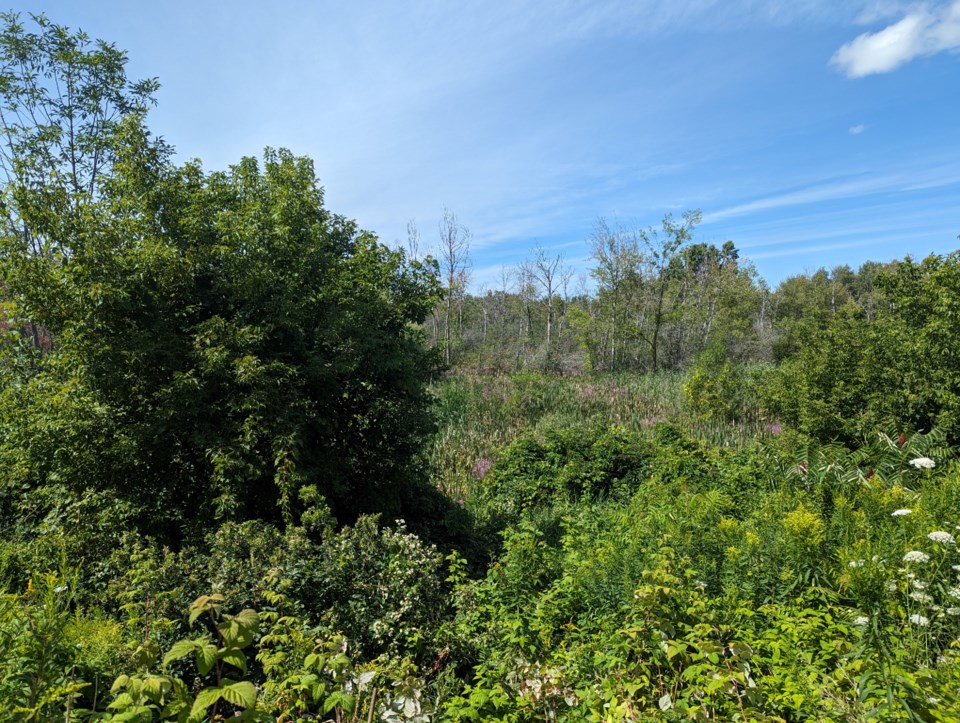It could cost three-quarters of a million dollars to dry out a Barrie neighbourhood, this year and next.
City councillors will consider a motion Aug. 16 for the capital construction and ongoing maintenance of a dewatering initiative at Marta Crescent and the Bear Creek wetland.
There would be a $350,000 cost this year, funded from the tax capital reserve, and an additional $400,000 to pay for ongoing operations and maintenance of the dewatering.
“The Bear Creek Wetland-Marta Crescent flooding issue is a major problem affecting several residents in my ward,” said Coun. Nigussie Nigussie, who represents this part of Barrie. He’s met with the residents and visited their properties. “Residents in this area are experiencing flooding from the Bear Creek Wetlands which makes it impossible to use their backyards.
“The sad thing is that children in the area can’t even play in their backyard.”
The proposed $350,000 interim solution developed by a consultant, Aquafor Beech, is to build a temporary coffer dam to isolate the backyards from the wetland and then pump the water out of that area.
The ongoing operating cost for this project is estimated at $50,000 a month, or $400,000 beginning next year, with expectations it would run for eight months of the year beginning in 2024, until a longer-term solution is implemented.
Nigussie said this flooding is not a new issue and has been raised by residents previously.
“Certainly, climate change is having an effect in several areas across our city and well beyond,” he said. “Given these homes back onto a natural wetland, the city is looking at solutions to resolve the flooding.”
This area is north of Summerset Drive, east of Marta Crescent and west of Gore Drive.
The city owns the parcel of land containing a portion of Bear Creek Wetland, a stormwater management facility and a watercourse known informally as Henderson Creek.
This land was dedicated to the city through the subdivision development process about 20 years ago. Other adjacent parcels containing the wetland are in private ownership. The Marta Crescent houses were built about 10 years ago.
Property owners on Marta Crescent have been reporting the wetland’s water has been rising during the years. The elevated water level means there is now standing water in the backyards of some homes on Marta.
Residents are concerned with this water from a safety, aesthetic, and enjoyment perspective, city staff say.
Aquafor Beech has been retained to study the problem and recommend both short- and long-term solutions.
Wetlands can change throughout the years, both naturally and because of human influence. Aquafor Beech’s assessment is the main drivers for the changes in the wetland are the deposition of sediment carried from Ardagh Bluffs, which has filled in a portion of Henderson Creek, and the increased prevalence of phragmites.
The province defines phragmites as an invasive, aggressive plant that spreads quickly and out-competes native species for water and nutrients. It releases toxins from its roots into the soil to hinder the growth of and kill surrounding plants. While it prefers areas of standing water, its roots can grow to extreme lengths, allowing it to survive in relatively dry areas.
The build-up of sediment and the phragmites have prevented water from flowing through Henderson Creek and has inundated the surrounding wetland, causing water levels to rise.
Long-term solutions are being studied, with the goal of maintaining a healthy wetland, restoring Henderson Creek, and minimizing the impact on downstream environments and properties.
While this work is in the very early stages, staff estimate these types of solutions will take many years and significant capital investment to implement. With that in mind, interim solutions were investigated which could be implemented in the short-term to reduce the standing water in the Marta Crescent backyards.



